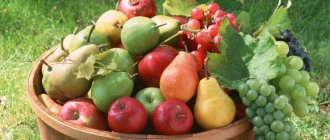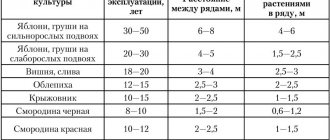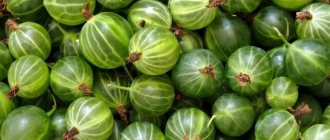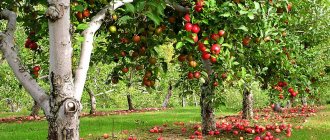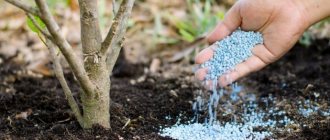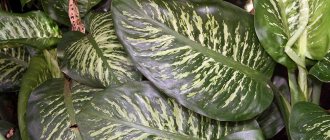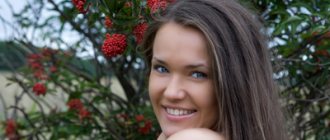What plants can be planted nearby?
This is perhaps one of the most important points that should be clarified before planting seedlings. Plant compatibility is called allelopathy . It can be both negative and positive.
The best compatibility of fruit trees will be achieved if plants of the same type are planted nearby: apple trees with apple trees, pears with pears, cherries with cherries. But such a garden of the same type will look quite boring. And therefore, in our gardens there are trees of different types, which are important to plant correctly. For example, a pear will feel great next to an apple tree and red rowan, while a cherry or peach will cause it a lot of inconvenience.
In the case of positive allelopathy, trees in the garden can not only exist safely in the neighborhood, but also be mutually beneficial. Therefore, before planning planting in the garden, it is recommended to check the compatibility table of various crops.
The walnut gets along the worst with its “neighbors” in the garden. This tree is considered toxic and can inhibit almost all fruit crops. Therefore, if you are going to have such a plant in your garden, find a place for it on the outskirts of the site, where it will not disturb anyone.
Preparing planting holes and planting trees in the garden
Before planting fruit trees in the garden, you need to properly prepare the planting holes or trenches. They should not be too small, in addition, you need to remember that fruit bushes and especially trees live for many years, which means they must be provided with good nutrition, especially for the first time, while the root system is not well developed.
Therefore, pits for planting fruit trees in the garden should be at least 70 x 70 cm in diameter and depth, and for shrubs - 40 x 40 cm. For golden currants - 60 cm in depth. For actinidia - 60 x 60 cm.
The soil taken out of the hole is placed as follows: the upper fertile layer - in one direction (it will be used to fill the hole), the lower clay layer - in the other (it can be partially used to create sides around the tree trunk circles), it is better to remove the rest of the soil from the site.
The pit is filled with fertile soil, which is prepared in advance: it is removed from the places where buildings and paths will be located, or it is brought specially.
Organic fertilizers are well-rotted waste of animal and plant origin. Typically, rotted grass and kitchen waste are called compost, and rotted manure is called humus. The use of such fertilizers not only improves the structure of the soil, but the plants also receive valuable nutrients.
Before planting trees in the garden, mineral phosphorus-potassium fertilizers are added to the bottom of the hole and thoroughly mixed with a certain amount of soil. Add to one planting hole:
- For apple and pear trees - 1 kg of superphosphate and 150 g of potassium sulfate
- For currants, chaenomeles and honeysuckle - 300 g of superphosphate and 40 g of potassium sulfate
Then a layer of soil without fertilizers is poured - the roots of the seedling should not come into contact with the fertilizers.
To plant fruit trees in the garden as required by proper agricultural technology, you need to add compost or humus to the planting hole. Fresh manure must not be used! For trees, add 2 buckets of organic matter, for shrubs - one. This supply of fertilizer will provide plants with nutrition for 3-4 years. Nitrogen fertilizers are not used during planting.
If the seedlings have an open root system (ORS), then you need to make a mound at the bottom of the hole and carefully spread the roots over it. Plants grown in a container are carefully removed from the planting container and their biological condition is assessed.
If the roots are too tightly intertwined in a ring at the bottom of the pot, they need to be untangled or cut and also spread over the mound at the bottom of the hole. If the roots of the earthen coma are not entwined strongly enough, it is better to move the plant into the planting hole without destroying it. All damaged roots are trimmed with sharp pruning shears.
When planting trees in the garden, the grafting cannot be deepened - this leads to undesirable consequences.
- Firstly , the trunk may rot at the bottom, which will lead to the death of the tree.
- Secondly , the scion can transfer to its own roots, and instead of a short tree, a rather large specimen will grow. Thirdly, in any case, the onset of fruiting of incorrectly planted trees is delayed for several years.
To prevent the planted tree from falling over from the wind, a support is installed next to the seedlings.
When planting apple and pear trees on a seed rootstock, the root collar should be at the level of the edge of the hole. Dwarf and semi-dwarf seedlings are buried so that the grafting site is 5 cm above the soil surface.
In the same way - by 5-8 cm - when planting, currant seedlings are buried, of course, if it is not a ready-made standard form. Honeysuckle and actinidia seedlings are planted at the same depth as they grew in the nursery.
After planting, the seedlings are well watered, even in rainy weather. Watering ensures the formation of good contact between roots and soil, which is necessary for plant survival.
If you planted ready-made seedlings, then all you have to do is maintain their appearance and provide them with proper care.
Below you will receive tips for caring for trees in the garden.
How to make a tree planting plan?
Choosing a site for the garden
Most trees prefer to grow in full sun. Therefore, the garden should be located so that light-loving crops (apricot, pear, peach, plum, cherry, apple tree) are located on the south or southwest side of the site. This is where they will grow and bear fruit best.
If the area allocated for planting trees on your site is small, the plants should be placed in stages: short ones on the south side, tall ones closer to the north.
Garden styles
When drawing up a garden plan, the first step is to decide in what pattern the trees will be planted. There are 2 main garden styles :
- regular (geometric),
- landscape (natural).
When planning a regular garden , crops must be positioned so that they form symmetrical shapes (squares or rectangles). It is advisable to “arrange” the trees in a row so that straight paths can be laid between them. It is permissible to place plants on the site in a checkerboard pattern - this way they will receive more sunlight.
If the site is on a hill, then the rows of trees should be placed across the slope.
Landscape style looks more natural - trees grow chaotically in nature. That is, you can place crops the way you want (taking into account the compatibility of plants and other factors affecting their successful growth). This method of planting fruit crops is suitable for uneven areas, with depressions and mounds, since such “flaws” in the relief will create the illusion of a natural composition.
Selection of types and varieties of fruit trees
Once you have decided on the location of the trees and the planting pattern, you should think about how many and what kind of plants should be planted. To do this, it is best to draw a rough plan of the site with all buildings and large objects. The selection of species and varieties of horticultural crops should be carried out so that they can pollinate each other.
For example, if you are planting apple trees, make sure that more than half of the seedlings are winter varieties. Their fruits will subsequently be stored until spring or even early summer.
The ripening period of the crop is also an important criterion. It is advisable to plant varieties with different ripening periods - this will extend the harvest period.
Distance between trees
In order for crops to have enough space for harmonious development, they must be planted at a certain distance from each other, as well as from buildings. Thus, cherries and plums should not be located closer than 3 m from the boundaries of the site (as well as from fences and buildings). It is advisable to plant apple and pear trees even further away from them.
The distance between the rows of trees grafted onto tall rootstocks should be on average about 5-6 m. In the rows between crops, a gap of 4-5 m should be left. If fruit crops are planted closer, they will begin to stretch ahead of time (they will stretch towards the sun ), their productivity will decrease, and the quality of the crop will deteriorate.
If you plan to plant trees with a small crown, the distance between them can be reduced by 0.5-1 m. If fruit trees and berry bushes are mixed, the distance between crops in rows should be increased by 1-2 m, and between rows by 1-1 m. 1.5 m.
| Culture | Row spacing (m) | Distance between plants in a row (m) |
| Apricot | 5-6 | 3-4 |
| Quince | 5-6 | 3-4 |
| Tall cherry | 4-5 | 3-4 |
| Low growing cherry | 3-4 | 2,5-3 |
| Pear on a vigorous rootstock | 6-8 | 4-6 |
| Pear on a weak growing rootstock | 4-5 | 1,5-2,5 |
| Sea buckthorn | 2,5-3 | 2-2,5 |
| Walnut | 6-8 | 4-5 |
| Peach | 5-6 | 3-4 |
| Tall plum | 4-5 | 3-4 |
| Low growing plum | 3-4 | 2,5-3 |
| Apple tree on a vigorous rootstock | 6-8 | 4-6 |
| Apple tree on a weak-growing rootstock | 4-5 | 1,5-2,5 |
Harvest Fruit Garden
How to place seedlings
When placing seedlings in the garden, be guided by the dimensions of an adult plant: for example, a tree 6 m high will have approximately the same crown diameter, and the root system will occupy an even larger volume.
Keep in mind the standard distances to buildings, communications, and fences. Too dense planting turns the orchard into an impenetrable jungle that does not produce a harvest. It is strictly not recommended to plant young trees in place of uprooted ones - try to retreat as far as possible. Coniferous plants (especially the combination of pear and juniper) are not the best neighbors for fruit trees: you are guaranteed a difficult fight against their common disease, rust, which has a complex development cycle involving both fruit and conifers. Leave as much free space as an adult plant needs. In large orchards, trees are arranged in rows, usually oriented north to south. In a private garden this is not always possible, so a possible option is to place them in groups of the same species while maintaining the required distances. Black currants, raspberries, actinidia and aronia are relatively shade-tolerant, but in full sun they feel better, which has a positive effect on both the yield and the decorative appearance of plants.
Also remember that pear, honeysuckle and stone fruits require cross-pollination; the garden (or neighbors) should have plants of the same species, but of a different variety. In sea buckthorn, for every 5 female plants, one male plant is planted.
In the online store and nursery of Agroholding POISK there is a large selection of seedlings of stone fruit crops, among which there are both self-fertile cultivars and good pollinators that can be planted in a garden where fruit trees that require cross-pollination are already growing. Be sure to pay attention to the information about the principle of pollination in the description of the plant (even if it is not on the label of the seedling or in the characteristics on the website, you can always look at the search page of the State Variety Commission and clarify this point by finding the desired variety and clicking on it).
For example, the 'Molodezhnaya' cherry is self-fertile, which means that it essentially does not need a pollinator to bear fruit. In such “independent” individuals, approximately 50% of the flowers are fertilized from their own pollen. If there is a pollinator nearby, there will be more ovaries. By the way, the fruits of this winter-hardy variety are large (up to 4.5 g), dark burgundy, sweet and sour with dense pulp.
Variety 'Molodezhnaya' - self-fertile
For comparison, the medium-ripening varieties 'Shokoladnitsa' and 'Oktava' are partially self-fertile. It is believed that in such cultivars only 20% of flowers turn into ovaries during self-pollination, so it is still advisable for them to plant pollinators next to each other, and then you will collect cherries in buckets.
But 'Shubinka', for example, is self-sterile; don't expect a harvest without a partner. It is better to place its relatives in close proximity, without alternating with plantings from other crops, such as apple or pear trees. The ideal case is when at least three different cherries grow nearby.
'Chocolate Girl' (left) and 'Octave' (center) are partially self-fertile. 'Shubinka' (right) - self-sterile
Plums, like cherries, will also bear fruit perfectly only if there is a partner - both self-fertile, like 'Zarechnaya Early' and 'Skorosplodnaya', and partially self-fertile, like 'Etude' and 'Volga Beauty'. By the way, this quartet is very successful: the fruits are different in taste and size, different ripening periods ('Etude' is mid-ripening, the rest are early).
Partially self-fertile: 1 - 'Zarechnaya early'; 2 - 'Precocious'. Self-sterile: 3 - 'Study'; 4 — 'Volga Beauty'
When to plant trees: autumn or spring?
Typically, trees are planted or replanted only when they are dormant: in spring or autumn. In summer, such a procedure is unsafe, since the plants are in the midst of the growing season. And if a young tree is disturbed at this time, then after suffering stress it risks getting sick or even dying. How to determine which season is the right time to plant trees? The choice depends on the climate zone.
| Region | Tree planting time |
| Southern regions | Trees are planted in autumn . Seedlings planted in spring run the risk of not having time to take root before the onset of hot weather. Therefore, they can get bark burns or die from lack of moisture in the soil. |
| Central regions | Trees can be planted both in spring and autumn . Regardless of the time of planting, the result will be approximately the same: in a temperate climate, seedlings of fruit crops will take root safely. |
| Northern regions | Trees are planted in spring . Not too hot spring and summer will allow the plants to adapt and go into winter dormancy in a timely manner. Fruit crops planted in the fall, on the contrary, will not be able to acclimatize in time and will die with the onset of the first frost. |
How to grow a good garden
Plants
We are building
Flowers
In the garden
Calendar
Vegetables
Animals
Mushrooms
Pests
Bees
Landscape design
home
» Work in the garden and vegetable garden
How to determine the suitability of a site for a garden?
If oak, maple, rowan, wild apple, pear, rose hip, legumes and cereals grew on the site of the future garden, then fruit trees can also grow here. Areas where alder, willow, and sedge grow are unsuitable for growing fruit crops. Such lands can be used for fruit, or better yet, berry crops only after their radical reclamation (drainage, drainage, liming).
The site should be developed by leveling its surface, filling holes, cutting off mounds and hummocks, removing stones, uprooting stumps and bushes. In low-lying and waterlogged parts of the terrain, it is recommended to install a sod-drainage network, and in elevated and dry places - to carry out irrigation. In waterlogged areas, it is advisable to plant fruit trees on mounds or rollers of soil.
What is air drainage?
Air drainage is the flow of cold (heavier) air from high places to low places. Good air drainage is observed on slopes. Cold air cannot flow into low places (pits, depressions, narrow closed valleys, forest clearings located in low places and closed by trees). There is almost no drainage in these places. If the garden has air drainage, the risk of damage to flowers by late spring frosts is reduced. Frosts of 1.5-2°C are dangerous for flowers of fruit crops, and frosts of 1°C for young ovaries.
Gardens should be planted on the upper and middle parts of slopes. In the lower parts of the slopes, gardens may die from freezing. The steepness of the slopes can be different, but gentle slopes (or convex slopes) with a steepness of up to 4-6°C are more suitable. Cherry grows better on the upper parts of steeper slopes.
Typically, plots for personal and collective gardens are allocated without taking into account the listed requirements. In such cases, you should pay attention to the features of the microrelief of each individual area, as well as the nature of the relief of the entire area allocated for the garden. Even before planting the garden, you need to plan the surface of the site so that there are no micro-depressions left on it.
How to protect the garden from the winds?
The harmful effect of winds is that they blow away snow from the soil surface in winter, increasing the risk of freezing of the root system of fruit trees and reducing the spring accumulation of water in the soil, drying out the soil, and interfering with the flight of bees. A strong wind breaks branches, tears off fruits and leaves.
If the garden plot does not have natural protection, then creating it is an important task for the gardener. The specific conditions of home gardens do not allow creating protective plantings around each garden plot, so you can make them around a collective garden. For protective plantings in the middle zone, linden, maple, elm, birch, and ash are used. For hedges - yellow acacia, hazel (hazel), jasmine, honeysuckle, rose hips, chokeberry.
Protecting the garden is especially important from the prevailing winds. When planting protective strips, it is important to consider that these strips must be blown through. To do this, trees in the protective strip are placed in 2 rows, the distance between trees in a row is 1-1.25 m, between rows - 1.5-3 m. Shrubs are placed in 1-2 rows, in a row at 0.5-0. 75 m, between rows 0.75-1.5 m.
How to determine landing sites?
Having chosen a tree placement scheme and drawn up a garden plan on paper, determine the planting location for each plant on the site. To do this, first choose the direction of the rows and their number. It is preferable to plant trees in straight rows with wide row spacing in order to grow vegetables, potatoes, strawberries, and flowers in a young garden.
The breakdown of the site begins by marking the original edges of the lines at right angles between them. The right angle is determined using a device. To do this, draw two lines intersecting at right angles on a planed board or square piece of thick plywood with sides 25-30 cm long. Thin nails are driven in at the intersection and at the ends of the drawn lines. The board or plywood is fixed on a straight strip and this device is used. You can also construct a right angle using wire cords, a tape measure and an ecker.
How to dig a planting hole?
A planting hole is needed to cultivate the soil for fruit plants. After planting trees, it is no longer possible to deeply cultivate the soil underneath them. Planting holes are dug like this: a piece of twine is loosely tied to the bottom of a stake placed at the tree planting site, and a peg is tied to its second end at a distance of 0.5 m from the stake, which is used to draw a circle on the ground. The area of this circle is the location of the planting hole.
When digging a hole, the soil from the arable horizon (the upper dark-colored part of the soil) is placed on one side of the hole, and the soil taken out from the lower part is placed on the other. The depth of the planting pit for pome crops is 60 cm, the diameter is 100 cm, for stone fruits it is 40 and 80 cm, respectively.
How to fill the soil with fertilizers?
When filling the soil, the task is to accumulate ash nutrients in the soil in a form accessible to the plant in advance for as long as possible. Amateur gardeners usually limit themselves to improving the soil in planting holes by adding fertilizers to them in higher doses. The rest of the site is refilled after planting for a number of years. To improve the podzolic soil in the rows of the garden, grasses are sown as green fertilizer, or they are limited to growing vegetables, applying fertilizers (organic and mineral) in higher doses.
How much fertilizer should I apply?
This depends primarily on the size of the hole - the larger the hole, the more fertilizer needs to be applied.
Mineral nitrogen fertilizers, if given organic, do not need to be applied. Lime is applied only if the soil is very acidic and does not produce ash. Approximate doses of fertilizer per hole depending on its size:
| Fertilizers | Planting hole size | |
| 100×60 cm | 80×40 cm | |
| pomaceae | stone fruit | |
| Organic (in buckets): | ||
| humus | 2-3 | 1-2 |
| composted peat | 2-5 | 1-2,5 |
| composts | 3-6 | 1,5-3 |
| Phosphorus (in kg): | ||
| a mixture of superphosphate and phosphate rock (at a ratio of 1:4) | 1,0-1,5 | 0,5 |
| simple superphosphate | 0,5-0,6 | 0,2-0,3 |
| double superphosphate | 0,3-0,4 | 0,15-0,2 |
| Potassium | ||
| wood ash (in kg) | 1,0 | 0,6 |
| potassium sulfate (in g) | 150-200 | 100-220 |
| potassium chloride (in g) | 100 | 40-60 |
Of course, it is necessary to apply not all the fertilizers indicated in the table, but only one of each type. Give soil directly to the roots without fertilizer or mixed with well-rotted compost. After planting, the soil in the planting hole must be watered abundantly and, when all the water has been absorbed, mulched with some organic fertilizer. In summer, in dry weather, new plantings should be watered, otherwise the doses of fertilizers indicated in the table will be too high and, with a small amount of water in the soil, will sharply increase the concentration of the soil solution, which will cause oppression of plants.
When to plant fruit trees?
Apple and pear trees can be planted both in the fall (in the first ten days of October, after the leaves fall) and in the spring (in late April - early May, before the buds open). It is better to plant cherries and plums in the spring (before the buds open). It should be remembered that during spring planting there is no delay.
Before planting, the torn and broken ends of the roots are trimmed to a healthy place with a sharp knife or pruning shears. The roots, at the ends of which callus has formed, are not cut off. In general, the more roots remain on the tree and the longer and more branched they are, the better and faster it takes root and grows after planting.
You cannot expose the roots in the fall during even slight frosts. All work with seedlings is carried out at temperatures above 0°C.
When planting, especially in clear and windy weather, it is necessary to protect the roots from drying out. To do this, it is better to remove the seedlings from the digging one at a time and plant them immediately. A seedling is placed in a hole made near the stake (Fig. 1). The transition point of the roots into the trunk, called the root collar (the root collar does not need to be mixed with the grafting site), should be 6-7 cm higher than the soil surrounding the pit for pome fruits, 4-5 cm for stone fruits. To fill the roots, soil is taken from the top layer without fertilizer. If you have old, well-decomposed compost, you can add it to the soil (1 part compost to 3 parts soil). Before pouring soil onto the roots, you need to break up the lumps.
It is more convenient to plant together: one holds the seedling, the other gradually adds soil with a shovel. Having filled the lower part of the roots, the soil is straightened by hand between the roots so that there are no voids left near them, or the seedling is shaken so that the soil spills out between the roots. Thin roots are straightened so that they are directed more or less evenly in all directions. Then they continue to gradually pour in the soil, all the time straightening it between the roots. When all the roots are covered, the soil is lightly compacted with feet. The foot is placed along a radius: toe to the tree, heel to the edge of the pit. Then, adding more soil, make a wide hole around the tree of such a size that two buckets of water can fit into it for the apple tree and one for the cherry tree. The main purpose of watering in this case is to ensure good soil contact with the roots. Watering is carried out even if the soil is sufficiently moist. When all the water has been absorbed, the hole is covered with earth; Peat or, better yet, loose compost should be poured on top of the ground around the tree in a layer of 4-5 cm. This layer protects the soil from evaporation (Fig. 2).
Is it possible to occupy inter-row spaces in a fruit-bearing garden?
It is possible, but as long as the trees do not shade the entire area. Usually vegetables, potatoes, and strawberries are grown in rows. You cannot grow grain crops, corn, or sunflowers between rows. It is dangerous to spray trees during the period when strawberries bloom or have ovaries, and vegetables have leaves or stems for food. To prevent pesticides from coming into contact with strawberries and vegetables, they must be covered with plastic film, paper or some other material before spraying. As the roots and crowns of trees grow, the area under strawberries, vegetables, and potatoes is reduced.
Under fruit-bearing trees, the soil is usually kept under black fallow and loosened after watering or rain.
Is it possible to sod the soil under fruit-bearing trees?
Can. Sodding (or lawn) under trees and between the rows of the garden makes it easier to care for the soil and trees, eliminating the need to add manure or compost to the soil. This improves the color and keeping quality of fruits, etc.
Sodding of the soil in a fruit-bearing garden is possible if the following conditions are met:
mow the grass with a lawn mower at least once every 10 days;
chop the cut grass (with the same mower) and leave it at the mowing site as mulch;
carry out irrigation by sprinkling, evenly wetting the soil to a depth of 60 cm;
apply nitrogen fertilizers to the soil in the spring, increasing the dose by 1.5-2 times;
spray the trees with a 0.5% aqueous solution of urea (50 g per 10 l) immediately after flowering and 2-3 weeks later, and with a 4% aqueous solution of urea (400 g per 10 l) in the fall, after harvesting ( before leaf fall) 15-20 liters of solution per tree;
Every year in the fall, place poisoned baits under the trees against mice, and trample the snow around the tree trunks in winter and spring.
What soil treatment methods can be used in the garden?
Most often, gardeners cultivate vegetables and strawberries in the rows of the garden, and dig up and loosen the soil under the crowns. But as tree crowns increase, growing conditions for inter-row crops worsen. And inter-row crops are undesirable for the life of fruit trees. Therefore, the strip allocated for inter-row crops should be gradually (annually) reduced.
The digging depth under the trees should be no more than 12-15 cm, and near the trunks - 10-12 cm. Of course, when sodding there is no need to dig up, loosen the soil and add manure or compost.
The loose and moist state of the soil in the garden can be maintained by mulching it with organic materials (manure, compost, peat, grass, dark-colored paper, etc.). Mulch the soil immediately after the first spring treatment. The thickness of the mulch layer should be 8-10 cm or more. To prevent the mulch from being blown away by the wind, it is covered with soil in several places. Weeds that appear on the mulch are pulled out. Apply mulch in the fall if the summer is dry. During wet summers, the mulch should be removed in August and used for composting.
Are weeds harmful to mature trees?
Harmful. Weeds, especially in dry weather and lack of watering, take a lot of water and nutrients from trees. Therefore, weeding or frequent (5-6 times) mowing them is a mandatory agrotechnical practice in the garden.
What kind of fertilizer and in what quantity should be applied to a fruit-bearing apple tree?
The soils are very varied in their fertility. In addition, they can be fueled differently before landing. It is impossible to determine exactly how much nutrients in the soil are available for the apple tree in a given period, even with the help of soil analysis. The gardener, as a rule, decides this issue taking into account the vigor of plant growth in previous years and the size of the harvest.
Average doses for clay and loamy podzolic soils: manure (or other equivalent fertilizer) 3-4 kg per 1 m2, mineral fertilizers - ammonium sulfate and superphosphate 45 g per 1 m2, potassium chloride (50%) 18-20 g, or in the active substance 9-10 g per 1 m2. If both organic and mineral fertilizers are applied in the same year, their doses are reduced by half.
On sandy and peat soils, nitrogen and phosphorus fertilizers are applied in the same doses, and the dose of potash is increased by 20-25%. On chernozem soils, the average dose of manure is 2-3 kg per 1 m2, and nitrogen, phosphorus and potassium are 7 g each (active ingredient). If possible, the dose of organic fertilizers should be increased.
On soils in which the upper part of the layer has been filled with phosphorus and potassium in previous years, fertilizers containing these elements can be applied once every 3 years (in the indicated doses) or annually, reducing their doses by 2-3 times. Nitrogen fertilizers are applied annually. In years of heavy (rejuvenating) pruning of the apple tree, as well as with a very high harvest, the dose of nitrogen fertilizer is increased and applied in two doses - early in the spring and at the end of June or early July (during the period of shedding of the ovaries).
When is it better to apply mineral fertilizers to fruit trees - in spring, summer or autumn?
It depends on the type of fertilizer and the purpose pursued when applying it. Potash fertilizers, which contain chlorine (potassium chloride, potassium salts), are best applied in the fall after harvesting winter varieties. In small doses, these fertilizers can be applied in the spring during the first tillage. Other potash fertilizers (potassium sulfate, wood ash), phosphorus and manure are applied either in the fall or in the spring. On sandy soils, potassium fertilizers can be applied in the summer, in June (as a top dressing). Nitrogen fertilizers on light soils are rarely applied in the fall, more often applied in the spring (before the first spring tillage); on clay and loamy (but not sandy) soils, fertilizers containing nitrogen in ammonia form can be applied in the fall (after harvesting winter varieties).
In summer, nitrogen fertilizers are mainly used for fertilizing.
When is it more effective to fertilize a fruit-bearing tree?
In the year of fruiting, the plant consumes more nutrients. Therefore, more fertilizer needs to be given at this time. Manure, phosphorus and potassium fertilizers are usually applied both in a harvest year and in a lean year, while nitrogen fertilizers are applied in different ways. In the year when there are no fruits or there are few of them, nitrogen fertilizers are applied once in the spring. If the leaves are light green in color, give another nitrogen supplement at the end of May - beginning of June. In a year with a high and average harvest, the dose of nitrogen fertilizers is increased. It is applied in the spring and additionally after the June shedding of the ovaries to ensure good growth of shoots and fruits. On sandy soils, when watering the garden, fertilizers are applied more often in the summer to the entire area of the tree trunk circle and row spacing.
Doses (including potassium), timing and methods of fertilizing a pear are the same as for an apple tree. The dose of potash fertilizers is increased by 10-15%.
Can fertilizing be used to replace the main fertilizer?
It is forbidden. Fertilizers are in addition to the main fertilizer. Only a combination of basic fertilizer and top dressing can give the best results. Doses of the main fertilizer are reduced if additional fertilizing is given, and vice versa. Fertilizing is especially necessary on light sandy soils.
Which fertilizers are more effective?
Fertilizers are more effective if fertilizers are applied dissolved in water. Fertilizing with dry fertilizers can be carried out only during heavy rains or watering.
What fertilizers are most suitable for liquid fertilizing?
Among mineral fertilizers, those that are easily soluble in water are suitable for this. Nitrogen fertilizers are all easily soluble in water, but if you have a choice, it is better to use those in which nitrogen is in the nitrate form - nitrate. Potassium fertilizers also dissolve easily in water (more quickly in hot water). Phosphorus fertilizers that are easily soluble in water include superphosphate and ammophos. They are usually used to feed plants. Soluble fertilizers are fruit and berry and other ready-made mixtures. Among organic fertilizers, slurry, bird droppings, and mullein are good for fertilizing, that is, those that dissolve in water or are easily mixed with it.
As a rule, phosphorus and potassium fertilizers are not applied to well-amended soils as summer feeding. An exception can only be on easily washed light soils in the presence of heavy rainfall or watering.
How to prepare fertilizers for feeding plants?
Fertilizers are dissolved in a small amount of water, and then this strong solution is diluted in the required amount of water.
Superphosphate is more difficult to dissolve than other fertilizers. Usually it is prepared at 3-5%. They do it like this. Pour half a bucket of water, pour 300-500 g of superphosphate (powdered or granulated) into it and mix thoroughly. Then, when the solution has settled a little, it is drained from the sediment, after which water is poured two more times in quarter-bucket portions. Each time the mash is stirred and drained from the sediment. With this treatment, superphosphate will go into solution, but a precipitate will remain. This is gypsum, which is included in simple superphosphate as an impurity.
The composition of fruit, berry and vegetable mixtures includes superphosphate, so when they dissolve, a sediment remains. It can be thrown under the trees, since the sulfur found there is needed for plants. Double superphosphate does not contain gypsum, so it dissolves completely, and if a sediment remains, it is small.
How to prepare liquid fertilizer from mullein?
They do it like this. The tub is half filled with mullein, then water is poured into it almost to the top. The contents of the tub are mixed several times. The result is a strong solution of mullein. The solution is left in the tub for 1-2 weeks to ferment. A strong solution (mullein) of mullein is usually diluted with water before being added to the soil. The drier the soil, the more water must be added in order to somewhat moisten the soil at the same time as fertilizing. Usually 3-4 buckets are added to a bucket of mullein mash. If the soil is moist, the solution can be made stronger by diluting it with water 2 times. A bucket of solution is added per 1 m2. If the mullein solution is strong (diluted 2 times), it is given less. In general, you need to give enough solution so that 1 m2 contains 2-3 kg of mullein itself (not counting water).
How to prepare liquid fertilizer from bird droppings?
First, mash is prepared from bird droppings, then diluted 3-4 times with water and immediately used for application to the soil. The doses for applying the chicken manure solution are the same as for liquid mullein fertilizer (a bucket of solution per 1 m2).
Is it possible to replace liquid mullein fertilizing with slurry?
It is possible, although the composition of liquid mullein is somewhat different from slurry. Slurry contains mainly nitrogen and potassium; there is very little phosphorus in it. To turn it into a complete fertilizer, you need to add 50-60 g of superphosphate to a bucket of slurry. Slurry is diluted 2 times with water before application.
How much fertilizer should be applied to a fruit tree or berry bush over the summer?
If the soil is well filled, phosphorus and potassium fertilizers are usually not applied in fertilizing. If the weather is dry in summer and the garden is not watered, then there is no point in giving nitrogen fertilizers, despite the fact that the plants grow poorly. They suffer from a lack of water, not from a lack of nitrogen. Under good growth conditions, nitrogen fertilizers are applied taking into account the vigor of growth and the color of the leaves. If the leaves are not dark green enough, give one or two nitrogen fertilizings in June - early July. On sandy soils, fertilizing is applied more often than on clay soils. Potassium is added to nitrogen.
At what distance from the plant, and in what quantity should liquid fertilizers be applied?
It is better to apply liquid fertilizers into the furrows made near the plant. They make them differently. The more of them, the better - most of the roots will come into contact with the fertilizer. Sometimes grooves are made only around the plant along the projection of the crown. For berry plants this is enough, but for fruit trees it is better to make several more grooves in addition to the annular groove (along the periphery of the crown) under the crown - in the radial direction from the trunk or several circular grooves. The grooves must be made wider, deep to the root layer. A fertilizer solution is poured into the grooves and, when it is absorbed, they are covered with soil.
The amount of solution is calculated based on the fertilizer for the entire area of the tree trunk circle. As an average dose, you can take 3-4 g of each fertilizer (active ingredient) per 1 m2 of tree trunk circle. How to calculate the dose of a particular fertilizer based on the active substance? The average dose for a fruit and berry mixture is 50 g per 1 m2.
The more fertilizer is dissolved, the better. If the soil is wet, you can make strong solutions; if the soil is dry, you can make weaker ones. You can give a fertilizer solution and then water the plant generously.
What is the deadline for summer application of nitrogen fertilizers?
The last time nitrogen fertilizer is often applied is soon after the ovaries fall off in June. Abundant nitrogen nutrition in the second half of summer reduces the winter hardiness of plants.
What is foliar feeding? How is it different from the root?
Foliar feeding is the introduction of nutrients into the plant through the leaves (sometimes through the trunk). With foliar feeding, nutrients reach the plants faster. This is their advantage. But foliar feeding cannot provide a lot of nutrients, since strong salt solutions can be harmful to the leaves. The main fertilizers should be considered root fertilizers, while foliar fertilizers are used as additional fertilizers. Many gardeners prefer to give microfertilizers in the form of foliar feeding.
How to carry out foliar feeding?
When foliar feeding, plants are sprayed with a nutrient solution so that it gets on the leaves. Plants should be sprayed either early in the morning or in the evening. During the day you can spray only in cloudy (but not rainy) weather so that the solution on the leaves does not dry out quickly.
It is necessary to carefully monitor the concentration of the solution.
Strong solutions of some fertilizers, especially nitrogen ones, burn the leaves. When spraying plants in the spring (with young leaves), it is necessary to use weaker solutions than when spraying plants with coarsened leaves. Among nitrogen fertilizers, preference should be given to urea. It can be used in stronger solutions than other nitrogen fertilizers. Doses of fertilizers for foliar feeding used in summer, in g per bucket of water
| Nutrient | Fertilizer | Dose | Nutrient | Fertilizer | Dose |
| Nitrogen | Urea* | 40 — 50 | Bor | Borax | 4 — 15 |
| Ammonium nitrate | 15 — 20 | Boric acid | 2,5 — 10 | ||
| Phosphorus | Superphosphate | 300 | Manganese | Manganese sulfate | 5 — 10 |
| Potassium | Potassium sulfate | 100 | Zinc | Zinc sulfate** | 2 — 5 |
| Potassium chloride | 50 | Copper | Copper sulfate | 1 — 2 | |
| Magnesium | Magnesium sulfate | 200 | Molybdenum | Molybdic acid ammonium | 1 — 3 |
* When maintaining garden rows under frequently mowed grasses, in addition to summer spraying before and immediately after flowering, autumn spraying is also used, shortly before leaf fall. During this period, the amount of urea is increased to 300-400 g per bucket of water.
** Sometimes zinc sulfate is sprayed on plants in a leafless state. In this case, the strength of the solution is increased to 200 g per bucket.
Note. Doses of microelements are sometimes increased.
Read other articles on this topic here.

